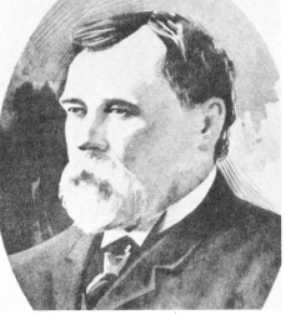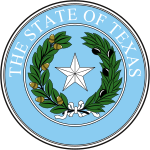
The 1896 United States presidential election was the 28th quadrennial presidential election, held on Tuesday, November 3, 1896. Former Governor William McKinley, the Republican nominee, defeated former Representative William Jennings Bryan, the Democratic nominee. The 1896 campaign, which took place during an economic depression known as the Panic of 1893, was a political realignment that ended the old Third Party System and began the Fourth Party System.

Murphy James Foster was the 31st Governor of the U.S. state of Louisiana, an office he held for two terms from 1892 to 1900. Foster supported the Louisiana Constitution of 1898, which effectively disfranchised the black majority, who were mostly Republicans. This led to Louisiana becoming a one-party Democratic state for several generations and excluding African Americans from the political system.

Charles Allen Culberson was an American political figure and Democrat who served as the 21st Governor of Texas from 1895 to 1899, and as a United States senator from Texas from 1899 to 1923.

Texas's 7th congressional district of the United States House of Representatives comprises a small area of southwestern Houston and Harris County, along with a northern portion of suburban Fort Bend County. As of the 2000 census, the 7th district comprises 651,620 people. Since 2019, it has been represented by Democrat Lizzie Fletcher.

The 1922 United States Senate elections were elections that occurred in the middle of Republican President Warren G. Harding's term. The 32 seats of Class 1 were contested in regular elections, and special elections were held to fill vacancies. With the Republicans divided between conservative and progressive factions, the Democrats gained six net seats from the Republicans while the Farmer–Labor party gained one. The Republicans retained their Senate majority.

The 1894 United States House of Representatives elections were held from June 4, 1894, to November 6, 1894, with special elections throughout the year. Elections were held to elect representatives from all 356 congressional districts across each of the 44 U.S. states at the time, as well as non-voting delegates from the inhabited U.S. territories. The winners of this election served in the 54th Congress, with seats apportioned among the states based on the 1890 United States census.

The 54th United States Congress was a meeting of the legislative branch of the United States federal government, consisting of the United States Senate and the United States House of Representatives. It met in Washington, D.C., from March 4, 1895, to March 4, 1897, during the last two years of Grover Cleveland's second presidency. The apportionment of seats in the House of Representatives was based on the 1890 United States census. The House had a Republican majority, and the Republicans were the largest party in the Senate.

The 1894–95 United States Senate elections were held on various dates in various states. As these U.S. Senate elections were prior to the ratification of the Seventeenth Amendment in 1913, senators were chosen by state legislatures. Senators were elected over a wide range of time throughout 1894 and 1895, and a seat may have been filled months late or remained vacant due to legislative deadlock. In these elections, terms were up for the senators in Class 2.

David Browning Culberson was a Confederate soldier, a Democratic U.S. Representative from Texas and Chairman of the House Judiciary Committee.

The 1896–97 United States Senate elections were held on various dates in various states. As these U.S. Senate elections were prior to the ratification of the Seventeenth Amendment in 1913, senators were chosen by state legislatures. Senators were elected over a wide range of time throughout 1896 and 1897, and a seat may have been filled months late or remained vacant due to legislative deadlock. In these elections, terms were up for the senators in Class 3.

The 1916 United States Senate election in Texas was held on November 7, 1916. Incumbent Democratic U.S. Senator Charles Culberson was re-elected to a fourth term in office. Culberson survived a challenge from former Governor Oscar Colquitt in the Democratic primary, then easily won the general election. He was challenged by Republican Alex W. Atcheson and Socialist Thomas Hickey, publisher of The Rebel.

The 1922 United States Senate election in Texas was held on November 7, 1922. Incumbent Democratic U.S. Senator Charles Culberson ran for re-election to a fifth term, but lost the Democratic primary. A runoff was held between former Governor Pa Ferguson and Railroads Commissioner Earle Bradford Mayfield.

The 1892 Texas gubernatorial election was held to elect the Governor of Texas. Incumbent Governor Jim Hogg was re-elected to a second term with a plurality of the vote over George W. Clark, an independent Democrat with the backing of the Republican Party and state railroad interests, and Populist judge T. L. Nugent.

The 1890 Texas gubernatorial election was held to elect the Governor of Texas. Attorney General Jim Hogg was elected over Republican Webster Flanagan.

The 1894 Texas gubernatorial election was held to elect the Governor of Texas. Attorney General Charles Culberson was elected Governor with a plurality of the vote over Populist candidate Thomas Nugent.

The 1898 Texas gubernatorial election was held to elect the Governor of Texas. Joseph D. Sayers was elected over Barnett Gibbs, a Populist running with Republican support.

The 1900 Texas gubernatorial election was held to elect the Governor of Texas. Incumbent Governor Joseph D. Sayers was re-elected to a second term in office.

The 1902 Texas gubernatorial election was held to elect the Governor of Texas. S. W. T. Lanham was elected over Republican George W. Burkett in a landslide.

The 1906 Texas gubernatorial election was held to elect the Governor of Texas. Thomas Mitchell Campbell was elected to a two-year term in office.

The 1908 Texas gubernatorial election was held to elect the Governor of Texas. Governor Thomas Mitchell Campbell was re-elected to a second term in office.


















